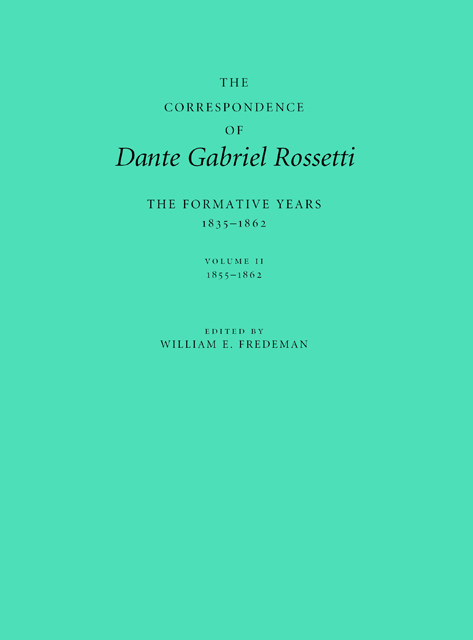 The Correspondence of Dante Gabriel Rossetti
The Correspondence of Dante Gabriel Rossetti Appendix: Thomas Griffiths Wainewright
Published online by Cambridge University Press: 18 March 2023
Summary
SUPPLEMENTARY NOTE TO 61.13
Thomas Griffiths Wainewright (1794-1847) is one of the most elusive, mysterious, maligned, and romanticized figures of the nineteenth century. More famous as a poisoner than an artist, he was never indicted for murder, though he came under strong suspicion of having poisoned his sister-in-law, Helen Abercromby, who, after seemingly conspiring with him and his wife Eliza Frances in an attempted insurance fraud, died mysteriously on 21 December 1830 at the age of 21. The insurance companies refused payment, and TGW, separated from his wife since 1831 and living in France, brought a claim against them. When the case came to trial - twice in 1835, first with a divided jury - inferences of nefarious motives were dismissed by the presiding justice, who instructed the second jury, who found against TGW, that there was “no evidence of other crime than fraud.” Returning to England in 1837, TGW was harboured by Theodore von Holst, but later apprehended and charged with forging a power of attorney 13 years earlier to gain access to a legacy of £5,200 left him by his grandfather, which he assigned to his wife. Found guilty of a forgery on the Bank of England, he was transported for life to Tasmania.
TGW studied art under Thomas Phillips, John Linnell, and Henry Fuseli - “the God of his worship” as TGW called him in his application for a ticket of leave to the Lieutenant Governor of Van Dieman's Land in 1844 - whose influence, along with Blake’s, is evident even in his later work. In 1825, after exhibiting five works at the RA between 1821-25, TGW was denied an Associateship in the RA and abandoned art. In the same year, he published his first and last book, Some Passages in the Life, &c. of Egomet Bonmot, Esq., a thinly veiled autobiography, written under another of his sobriquets and prefaced with a revealing mock-obituary by Bonmot's “life-long friend, Mr. Mwaughmaim.”
In large part the author of his own misfortunes, TGW is also partially responsible for the mythologizing that dominates most accounts of his life. By electing to publish entirely pseudonymously, he assumed the role of poseur and courted speculation about his personality and activities.
- Type
- Chapter
- Information
- The Correspondence of Dante Gabriel RossettiThe Formative Years, 1835-1862: Charlotte Street to Cheyne Walk. II. 1855-1862, pp. 523 - 527Publisher: Boydell & BrewerPrint publication year: 2005


